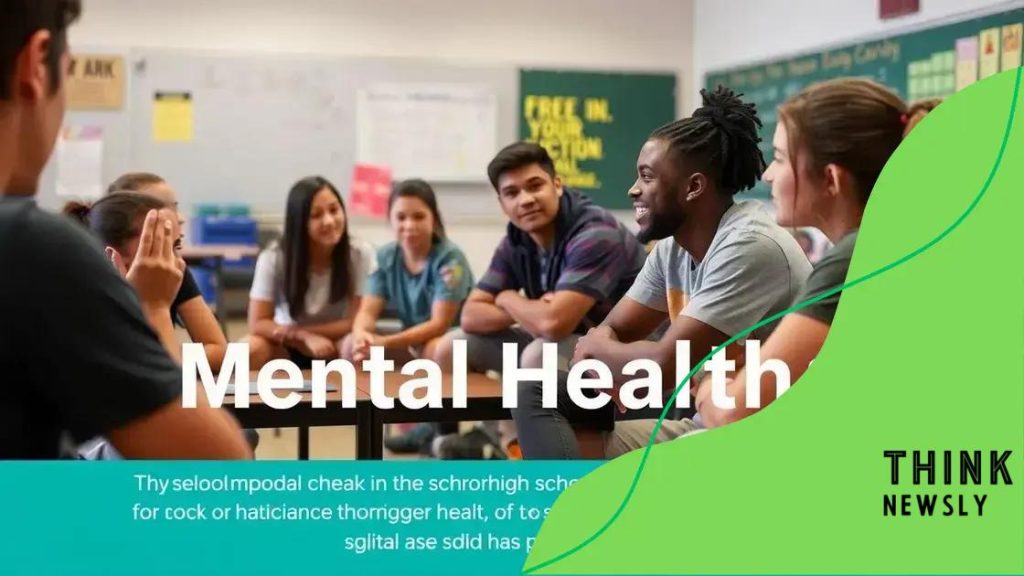Teen mental health taught in PE: why it matters

Anúncios
Teen mental health taught in PE is essential for developing emotional resilience, building supportive peer relationships, and incorporating physical activity, which collectively enhance students’ overall well-being.
Teen mental health taught in PE is becoming increasingly important as schools recognize the role physical education plays in overall well-being. But have you ever wondered how integrating mental health topics in these classes can shape students’ lives?
Anúncios
Understanding the importance of mental health education
Understanding the importance of mental health education in schools has gained significant traction in recent years. As students navigate their teenage years, they face various challenges, both academically and personally. Addressing mental health in the classroom, especially in physical education (PE), can lead to a better understanding of their emotions and improve overall well-being.
Why Mental Health Education Matters
Teaching mental health in PE promotes a healthy lifestyle that encompasses both physical and emotional fitness. When students learn about mental health, they are more likely to discuss their feelings and seek help when needed. Understanding these concepts early can prevent issues later in life, such as anxiety and depression.
Moreover, connecting physical activities with mental health helps students realize the impact exercise has on their emotions. For instance, regular physical activity can boost mood and reduce feelings of stress.
Anúncios
Key Components of Mental Health Education
- Emotional awareness: Learning to recognize and express feelings.
- Stress management: Techniques for coping with pressures and challenges.
- Resilience building: Developing skills to overcome adversity.
- Social skills: Fostering healthy relationships and effective communication.
By integrating these components into PE, educators create a supportive environment where students learn not only physical skills but also how to maintain their emotional health. Beyond theory, such lessons can be applied in daily life, enhancing students’ ability to deal with real-world challenges.
As students participate in team activities, they also practice collaboration and support, which are vital for emotional growth. Moreover, discussing mental health topics during PE opens doors for students to share their struggles and triumphs in a non-threatening environment.
In summary, promoting mental health education within physical education classes provides students with valuable tools. They leave not only as stronger athletes but also as more informed, emotionally resilient individuals. This holistic approach ensures that as they grow into young adults, they are equipped to handle the challenges they encounter in life.
How PE classes can address mental health issues
How PE classes can address mental health issues is an important topic in modern education. Physical education plays a crucial role in promoting not just physical fitness but also mental well-being among students. Recognizing the link between physical activity and emotional health can lead to a more comprehensive approach to student wellness.
Creating a Supportive Environment
PE classes are unique settings where students can engage in both physical and social activities. These environments can be designed to foster open discussions about mental health. When teachers and coaches encourage sharing feelings and experiences, they help break down stigma and promote understanding.
Incorporating strategies such as cooperative games and team-building exercises can enhance relational dynamics. This not only improves communication but also builds trust among peers, making it easier for students to reach out for help if they are struggling.
Incorporating Mindfulness Activities
Another effective way to address mental health in PE is through mindfulness practices. Introducing activities like yoga and meditation during class can help students learn to manage stress and anxiety. These practices promote relaxation and can have positive effects on academic performance as well.
- Mindfulness techniques reduce stress levels.
- Yoga encourages physical flexibility and mental clarity.
- Meditation can improve focus and concentration.
When students engage in these activities, they develop coping strategies that they can use outside of the classroom. Integrating mindfulness into PE classes also teaches students that taking care of their mental health is just as important as their physical health.
Engaging students in discussions about the science behind exercise and its effects on mood can spark interest and encourage lifelong healthy habits. For example, understanding how physical activity releases endorphins can motivate students to remain active and seek out exercise as a healthy coping mechanism.
By addressing mental health through PE classes, educators encourage students to develop a more well-rounded approach to their health. They learn that both emotional and physical aspects of well-being are interconnected. This lifelong lesson can help shape healthier adults who prioritize their mental health.
Practical strategies for teachers to integrate mental health

Practical strategies for teachers to integrate mental health into physical education are essential for creating a supportive learning environment. Teachers can take simple yet effective steps to ensure that mental health becomes a core part of their curriculum. These strategies not only enhance students’ understanding but also help develop their emotional resilience.
Encouraging Open Communication
One of the most important strategies is to encourage open communication about mental health. Teachers should create an atmosphere where students feel comfortable discussing their feelings. This can be done by initiating discussions about stress, anxiety, and emotional well-being at the start of PE classes.
Using prompts and questions can help students open up. For example, asking, “How are you feeling today?” or “What helps you relax?” can spark valuable conversations. Building trust is key, so showing empathy and actively listening to students reinforces that their feelings are valid.
Incorporating Team-Building Activities
Team-building activities are another effective way to promote mental health. These activities not only foster teamwork but also build friendships. When students work together, they develop social skills and learn to support one another. Simple games that require collaboration can be very impactful.
- Relays that require teamwork and communication.
- Group challenges that emphasize problem-solving.
- Activities that involve sharing personal goals or achievements.
Integrating such activities regularly helps build a community within the classroom, making students more likely to reach out for support when they need it.
Another method is to implement mental health awareness days. Designating certain days to focus on mental health topics can help educate students about the importance of emotional well-being. Teachers can organize workshops or guest speakers to share insights on managing stress and building resilience.
Additionally, utilizing mindfulness techniques such as breathing exercises before physical activities can prepare students mentally. Teaching students to be present during classes enhances focus and reduces anxiety, leading to a more positive PE experience.
Ultimately, by integrating these practical strategies, teachers play a vital role in promoting a balanced approach to physical and mental health. This holistic perspective helps students understand the importance of taking care of their minds as well as their bodies, setting the stage for healthier future generations.
The role of sports in promoting mental well-being
The role of sports in promoting mental well-being is significant, especially for teenagers. Engaging in sports can elevate mood, boost confidence, and foster resilience. When students participate in physical activities, they experience numerous benefits that go beyond physical health.
Physical Activity and Mental Health
Research shows that regular physical activity releases endorphins, often referred to as “feel-good hormones.” These chemicals can improve mood and reduce feelings of stress and anxiety. In team sports, students often find a sense of belonging, which is essential for their emotional health.
Additionally, sports provide an outlet for pent-up energy and frustrations. This can lead to better focus in both academic and athletic endeavors. Participating in sports also encourages routine and discipline, helping students learn how to manage their time effectively.
Building Social Connections
Sports naturally foster social interactions. When students play together, they build friendships and develop important social skills. The camaraderie formed during practices and games creates a supportive environment. This sense of community can be crucial for those struggling with mental health challenges.
- Encouragement from teammates helps build self-esteem.
- Collaborative efforts teach communication and cooperation.
- Positive reinforcement from coaches enhances motivation.
The relationships built through sports can also offer a crucial support system. Teens who play sports often find they have peers they can confide in, which can alleviate feelings of loneliness.
Moreover, sports can teach valuable life skills, such as overcoming adversity and handling wins and losses. These lessons contribute to greater emotional maturity and resilience, qualities that carry into other areas of life.
In conclusion, sports play an essential role in promoting mental well-being among teens. By engaging in physical activities, students improve their emotional health, build strong social connections, and learn valuable skills. This holistic approach to health is directly beneficial for their overall development.
Listening to students: feedback on mental health initiatives
Listening to students: feedback on mental health initiatives is crucial for creating effective mental health programs in schools. When students feel heard, they are more likely to engage and benefit from these initiatives. Collecting feedback is an important step to ensure that programs are relevant and meet the needs of the student body.
The Importance of Student Feedback
Gathering feedback allows teachers and administrators to understand the genuine concerns and thoughts of students regarding mental health resources. Students might have insights that educators may overlook. Direct communication can reveal which initiatives are helpful and which need improvement.
Surveys and open forums can be excellent methods for collecting this feedback. Both provide students with a safe space to express their feelings and suggestions. By using anonymous surveys, schools can ensure that students are honest without fear of judgment.
Creating a Safe Space
It’s essential to create a supportive environment where students feel comfortable sharing their thoughts. This can be accomplished during PE classes or dedicated health days when mental health is the focus. Encouraging open discussions about mental health removes stigma and empowers students to voice their opinions.
- Hold regular feedback sessions to gather student thoughts.
- Use anonymous suggestion boxes for ongoing input.
- Encourage peer-led discussions to promote honesty.
Implementing changes based on this feedback helps students feel valued and respected. When they see their ideas being taken seriously, it fosters a sense of ownership over their mental health initiatives.
Moreover, involving students in the development of mental health programs can provide greater insight into what strategies will be most effective. Peer-to-peer support programs, for example, can be more meaningful when students help design them. This approach not only meets their needs better but also encourages greater participation.
By actively listening to students, schools can refine and adapt their mental health initiatives to be more effective. This collaborative approach builds a stronger community and supports the emotional well-being of all students.
FAQ – Frequently Asked Questions on Mental Health in PE Classes
Why is mental health education important in schools?
Mental health education promotes awareness and understanding among students, helping them cope with challenges and reducing stigma.
How can teachers support students’ mental health in PE?
Teachers can support mental health by encouraging open communication, incorporating team activities, and listening to student feedback.
What role do sports play in mental well-being?
Sports can elevate mood, foster social connections, and teach valuable life skills that contribute to emotional resilience.
How can student feedback improve mental health initiatives?
Student feedback provides insights into their needs and preferences, allowing schools to tailor programs that effectively support mental health.





